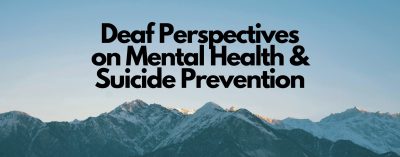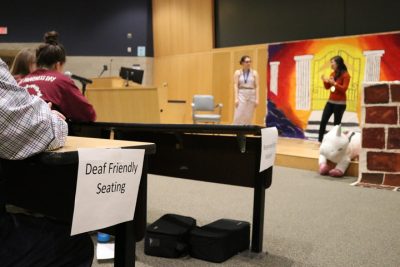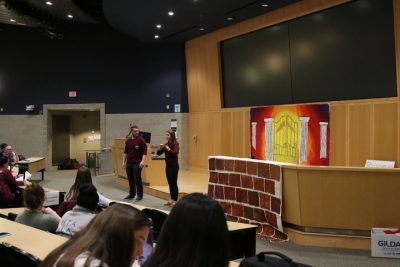I am a 39-year-old white male professor in a department of English and modern languages at a regional institution in central Texas, and I have spent the last 12 years teaching courses in technical writing, editing and usability. I have published in the top journals in my field, worked part-time in administration and was promoted this month to full professor.
And I am a deaf man who can no longer read your mask-covered lips during a pandemic.
Let me describe for you what I hear, like I do for my students on the first day of class. I am hearing impaired. Medical terminology is problematic for the Deaf: to describe myself as impaired rather than whole. But students understand impairment. Most are able-bodied; I am not. I show students an audiogram with the expected range of hearing highlighted in a bright, bold color: your line is probably straight, while mine is an exponential decline. Technical details help, too. I can hear everything under 250 hertz, everything left of middle C on a piano. By 2,000 hertz, three octaves higher, I am completely deaf. Descriptions of sounds and analogies work, too. I cannot hear whistles, bells, ringtones, birds, babies, the sound of an “S.” Imagine a graphic equalizer with the treble turned down. Imagine reading a book, but everything is fuzzy — dyslexia for the ears.
But the best descriptions are narrations, the experiential data. I can’t hear the siren when the police try to pull me over. That has the potential of getting me into trouble with the law, and it has. The students usually laugh at this point — unintentional anarchy from their college professor. I tell them another funny story: how I fouled a kid on the basketball court and continued to play, scoring a basket, praising myself and looking back to see the whole gym watching the deaf kid playing his own game. I didn’t hear the referee’s whistle. I tell them that I won a university contest with the opening line “I’ve never heard a baby cry.” Pathos is a great persuader, as is a baby’s cry.
Then I’ll demonstrate lipreading, a medium that is wholly unlike reading. Reading is decontextualized, and words can be reread. But reading lips is mostly sophisticated guesswork — ramp up the brain’s processor and fill in the missing gaps, like doing real-time jigsaw puzzle work. I tell them that context clues plus lip motions plus muffled sounds equal my best guess. In order to get a laugh about how few visemes exist in English, I tell them about the time I called out “T-bone” when my fitness instructor asked us to say a “state” while doing a push-up. I pair students up and tell them to have silent conversations with just their mouths, no sound. More laughter. We’ll watch a video from “Bad Lip Reading.” More laughter. It helps to make the uncomfortable palatable with humor.
Once the performance is over, I’ll remind them of the unfunny policy that I place in every syllabus: look at me, speak normally and don’t cover your lips.
Deeper Into My World
In March, since COVID-19, a singular question emerges: How to read lips that are covered by masks? By June, my university makes wearing a mask mandatory for the fall semester. I panic. I rant to my wife. I email administration, the ADA office, task force committees, my deaf colleagues. What the hell are the deaf and hard-of-hearing supposed to do in a world where lips can no longer be read? I get reassurances and promises that “we’ll” work with me. We’ll get face shields and signage. We’ll push content online. We’ll accommodate you.
Yes, accommodate me. Please do. That is a necessary start and a legal obligation. But the etymology of “accommodate” is to fit something into something else. I’m on the outside; you are on the inside. You’ll find space for me, room for me in the inn.
But come deeper into my world. Try growing up every day knowing that you are less than everyone else. All your terms that might describe me convey a sense of negation, loss or brokenness: disabled. Impaired. Hard-of-hearing. Abnormal. Hearing loss. Each connotation creates a sense of alienation by labeling my inferiority.
I learned that I was broken in kindergarten. My earliest deaf memory is watching Disney’s Robin Hood in the next-door classroom. I remember the rapture of listening to the serenade between Robin Hood and Maid Marian as they sang among the fireflies and waterfalls. Then I felt a tap on my shoulder. My class had gone back to our room. I had been left behind. The rapture had actually occurred and only I remained. Embarrassment followed recognition: I didn’t hear like everyone else. I started wearing hearing aids.
In second grade, my peers and I became acutely aware of the other. “Us” didn’t interact with “them,” and as a deaf kid, I desperately wanted to be part of “us.” A young girl in my class, with albinism, looked different. She had “albino germs,” and touching her was the quickest way to become a social pariah. You had to cross your fingers at all times or else you would be contaminated. I participated and crossed mine. It wasn’t germs that created isolation; it was difference. Our fingers were masks well before COVID.
In late high school, I stopped wearing hearing aids because they didn’t help me hear high-pitched sounds, and they amplified the low-pitched sounds enough to give me headaches. I remember putting on super-powered hearing aids and hearing the crunch of gravel under my feet as I walked through a parking lot, and I discovered that I don’t need to hear the crunch of gravel in a parking lot; you might. But mainly, the aids labeled me a priori as “deaf” and the never-escaping accompaniment of “dumb.” I desperately wanted to meet someone and have them know me; the hearing aid was a mask, not my primary identity.
By the time I was in college, I dabbled in flipping the narrative. Deaf pride. Deaf gain. I am special, unique and cooler than you. I published a poem my senior year of college, and I read it to a room full of applause, telling the audience that I heard more than they did, deconstructing their privilege, showing that my loss allowed me to transcend the noise of their everyday life. Humility was replaced with exceptionalism. Deficit was replaced with asset.
For the last decade, I have slowly learned to advocate for the Deaf, for myself. Deafness is a hidden disability, so I make it present. I sometimes wear a “Deaf Cyclist” badge when I ride my bike. I tell my daughter, daily, that I cannot hear her without seeing her lips. I was on the television show American Ninja Warrior for one season, talking about the challenges of the Deaf. I email people I’ve never met, asking for accommodations before meetings. I play my guitar in public, not really caring if the missed notes and poor dynamics offend your ears; I play because an incomplete song is still beautiful to mine.
Business as Usual
This fall semester, I’m a kindergartener again, sitting in the classroom in my own world. The hearing aids are back in a new form. I have a name tag sign that says “I am DEAF. I READ lips” as a reminder to everyone around me that their mask is hiding their mouth. I am labeled again. In all caps. Thankfully, again, I am a tall middle-aged white man. If I were young, old or a woman, this label would position me as particularly vulnerable since I advertise my weakness.
You can still incapacitate me, though, even as you seek to accommodate me with a clear mask. Let me tell you the terrible secret that no one talks about with lipreading: when you speak, I must turn my head to listen. Like horse blinders, your mouth controls my eyes, and when you control my eyes, you render me powerless. I cannot choose to not read your lips; you know when I am not paying attention. My constant fear as a student was that my teacher would say, “Kevin, are you listening?” My eyes gave me away. I always sat in the front row in rapt attention, exhausting myself, swallowing the anxiety, perhaps the only one in the mass of uninterested kids. They could choose not to listen; I could not.
So I hide from people more often, now, cementing the alienation. I avoid you in the hallways. I avoid looking at your lips behind the clear face shields to avoid being captured. I stay at home where the sounds are my own, set at a volume that I choose.
And tonight, after supper, my wife is rubbing my tight shoulders and neck. Halfway through the massage, I realize that my right leg is also tense; the adductor has pulled my body inward on itself. I forcibly relax it. Then I notice my right pinkie is folded down into my palm, digging, turning on itself like a cannibal. I relax it, too. And I notice how I am hunched over, so I take a full breath for the first time in several hours. My diaphragm expands, relaxes and releases me for a moment. These moments are the therapies of years of disappearing — of drawing my body inward like a turtle in a shell, curling up into a fetal position and suffering from upper-crossed syndrome and the unnameable maladies of tight fascia, decades of scar tissue that never healed right.
How can it be otherwise? I cannot even drive my car without anxiety. I am more likely to be the victim of police brutality if I am pulled over. The officer has a gun and hearing; I don’t. I’ve always avoided places where my back might be turned to their muzzle: the dark streets at night and the late-night snack runs. Lips cannot be read in the dark. Now I cannot even join my colleagues on campus during the day and safely protest against police brutality because I might not hear the warning cries as the unknown and unexpected unfolds.
I returned to the office recently for the first week of the fall semester. I posted a photo to Facebook and captioned it “Back in the office. Business as … usual?” with my ADA signs in the background indicating that visitors are entering a deaf and hard-of-hearing area that was safe for me, face shields required. A former student saw my post, and he contacted me last week. He said that he, too, was deaf in the high-frequency ranges, and he mostly kept it secret. He disliked his hearing aids, though the new ones nearly disappeared in the ear canal, preserving his secret. He disliked the labels, the ADA accommodations, the masks, but he wanted to stay hidden. We are invisible, just like our alienation is invisible.
Yes, business as usual. I walk around campus. Everyone is wearing a mask and socially distancing, present but hiding. The masks are the today’s crossed fingers: no, I don’t have albino germs or COVID, and if you don’t cross your fingers and wear a mask, you do. Us and them, again. But now, I can no longer talk to you or my former students, colleagues or friends. To engage you means that you cannot reply behind your mask.
In meetings, the opaque masks dictate the flow of the conversation. I sit there, unable to follow. In class, I cannot get close enough to my students to read their lips behind the face shields because of social distancing rules, so my students are increasingly silent. In the hallways, I hear the laughter of my colleagues, the stories, the connections, the relationships, but I hesitate to emerge from my office because hallways are masks-only. Relationships are built with daily attention to the absences that threaten to dissolve it, built not on digital communication alone, but smiles and frowns. I haven’t been able to carefully attend to a relationship with hardly anyone besides my wife and child for six months. A student on campus isn’t wearing a mask, and I find myself raging: yes, I can see your lips, but they are unwelcome. I suffer in silence to preserve us while you pretend the world isn’t changing. How nice to have resolved dissonance so easily.
Dichotomous Realities
Dissonance for me has always been a never-ending, daily struggle. I am Deaf, but I am also hearing. I am loss, but I am also more. I am alienated, but I am seen. I am the embodiment of a lived-world dialectic: to be both and neither at the same time, dissonance that can never be resolved.
Perhaps you can understand. COVID-19 has created a never-ending dialectic for us all, a world of continued uncertainty and anxiety. I read an article that humans cannot live in a constant state of uncertainty without having anxiety, but that is my job: to teach students to think critically, to question, to embrace dissonance. Learning cannot take place without it. And COVID-19 is a better teacher than I. Each day, we all face the same absurd, dichotomous realities: the mask says that you might have COVID-19. I might, too. But we don’t know. We must behave as if, but never as is.
My classes are dialectics now. I teach my class in person, but we must be ready to go online if the COVID-19 cases grow exponentially. I tell my students that the syllabus policies matter, especially the attendance policy: you must attend class. But not really, because no one wants you to come to campus with symptoms and infect us. So yes, the policies matter, but not really. Yes, the class is face-to-face, but not really.
Perhaps we are living in the greatest of all dialectics: philosophy and rhetoric. Truth with a capital “T” versus truth with a lower-case “t.” Permanency versus change. Reality versus appearance. Sameness versus difference. The world is changing, and we don’t want it to. The mask hides me, but like you, I’ve always been hiding. You can never see the me behind the masks that I’ve always worn, that I am wearing and that I will wear long after the pandemic.
But you can try. If you come to my campus, stop by my office. I’ll invite you to take off your mask, put on a face shield and step into my office. It won’t be risk-free for your body, but especially not for your mind. Communication always endangers your carefully curated view of the world. In fact, I suspect that if you look at my lips, get trapped in my monologue and uncross your fingers, you’ll find that we are both alone and scared, but we are learning. The invitation stands.



